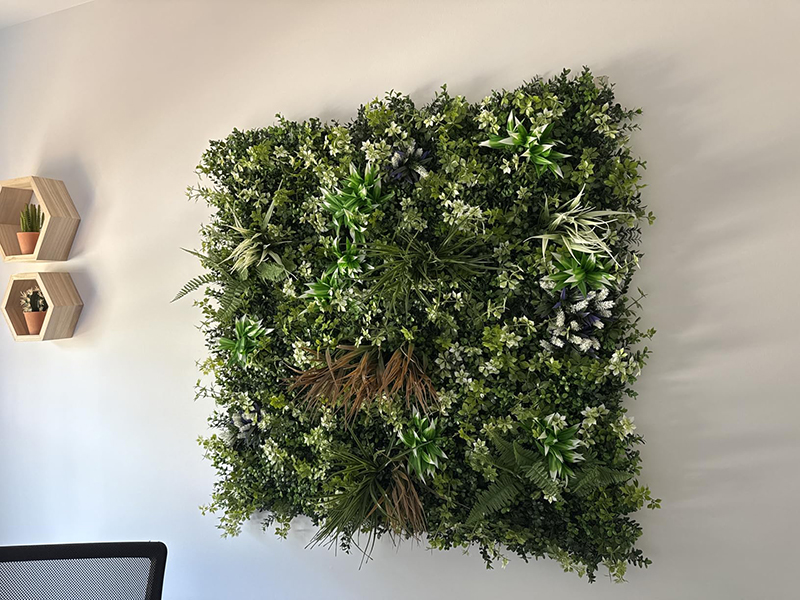3D artificial vertical gardens transcend traditional landscaping by serving as canvases for artistic innovation, blending nature-inspired aesthetics with human creativity. These installations redefine urban spaces, transforming walls, facades, and interiors into dynamic works of art that engage the senses and inspire dialogue. Below are key artistic approaches that elevate vertical gardens beyond mere greenery.
One of the most compelling artistic strategies in vertical gardens is thematic storytelling, where plant species, colors, and arrangements convey narratives or evoke emotions. For instance, a garden installed in a museum might use artificial foliage to recreate a historical ecosystem, such as a prehistoric jungle or a medieval herb garden. Each plant variety could represent a species from that era, paired with interpretive signage to educate visitors.
In corporate settings, vertical gardens might reflect a company’s values or mission. A tech firm could design a garden with metallic-toned artificial plants and geometric patterns to symbolize innovation, while a wellness center might opt for soft, flowing forms and calming hues to promote relaxation. Thematic gardens also lend themselves to cultural celebrations, with seasonal displays that honor holidays or local traditions through symbolic plant choices.
The layout of the garden plays a crucial role in storytelling. Designers can create focal points, pathways, or layers to guide the viewer’s eye and enhance the narrative. For example, a garden might feature a central "tree" made of artificial branches, with smaller plants radiating outward to represent growth or community.
To amplify their artistic impact, vertical gardens often incorporate lighting and sound elements that transform them into multisensory installations. Strategically placed LED lights can highlight specific plants, create shadows, or simulate natural phenomena like sunrise or moonlight. For example, a garden in a nightclub might use pulsating lights synchronized with music to evoke energy and movement, while a library installation could employ warm, ambient lighting to foster tranquility.
Sound design further enriches the experience. Some gardens include hidden speakers that play nature sounds, such as birdsong or rustling leaves, to deepen the connection to the outdoors. In interactive installations, sensors might trigger sound effects when visitors approach certain areas, adding an element of surprise and engagement. For instance, touching a panel could activate the sound of raindrops or a gentle breeze.
The combination of lighting and sound allows vertical gardens to adapt to different times of day or moods. A garden might transition from a serene daytime retreat to a vibrant evening spectacle, offering diverse experiences without altering its physical structure.
Artistic vertical gardens often push the boundaries of form and function by incorporating sculptural or kinetic elements. Sculptural gardens treat plants as three-dimensional art objects, arranging them in abstract shapes or figures. For example, a garden might feature a towering spiral of artificial ferns or a mosaic of succulents shaped like a portrait. These designs challenge viewers to see greenery not just as a backdrop but as a primary artistic medium.
Kinetic gardens take interactivity a step further by introducing movement. Wind-activated panels, rotating elements, or motorized components can create ever-changing patterns and textures. A kinetic garden might use lightweight artificial vines that sway gently in the breeze, or it could incorporate mechanical parts that shift the plants’ positions at regular intervals. This dynamism ensures that the garden never looks the same twice, encouraging repeat visits.
Both sculptural and kinetic gardens blur the line between art and nature, inviting viewers to reconsider their relationship with the environment. They also demonstrate how artificial plants can be used to achieve effects that would be impossible with living flora, such as precise geometric patterns or unnatural color combinations.
Many vertical gardens are the result of collaborations between landscapers, artists, and architects, resulting in truly unique aesthetic expressions. These partnerships allow for the integration of unconventional materials, techniques, or concepts. For example, an artist might contribute hand-painted artificial leaves or incorporate recycled materials into the garden’s frame, adding a layer of personal expression.
In public art projects, vertical gardens often serve as platforms for community engagement. Designers might host workshops where residents contribute to the garden’s creation, such as painting panels or arranging plants. This collaborative approach fosters a sense of ownership and pride, turning the garden into a shared cultural asset.
Collaborations also enable vertical gardens to address social or environmental issues. An installation might use plants to spell out messages about sustainability or climate action, while incorporating recycled materials to highlight waste reduction. These gardens become catalysts for conversation and change, merging art with activism.
Artistic vertical gardens are rarely static; many are designed to evolve in response to external factors or user interactions. For example, a garden might incorporate modular panels that can be rearranged seasonally or annually, allowing the artwork to "grow" or "transform" over time. Designers could also plan for the gradual addition of new elements, such as seasonal decorations or themed updates.
Interactive gardens take adaptability to the next level by responding to human input. Sensors might detect motion, touch, or sound, triggering changes in lighting, plant movement, or soundscapes. In a children’s museum, for instance, a vertical garden could light up or play music when kids interact with it, creating a playful and educational experience.
By embracing adaptability, vertical gardens remain relevant and engaging long after their installation. They become living artworks that reflect the passage of time, the changing needs of their users, and the evolving priorities of their communities.
The artistic potential of 3D artificial vertical gardens is boundless, offering designers and artists a versatile medium to explore themes, engage audiences, and reimagine urban spaces. Through thematic storytelling, immersive sensory experiences, sculptural innovation, collaborative creativity, and adaptive design, these gardens transcend their functional role to become cultural landmarks. As cities continue to seek ways to blend nature and art, vertical gardens will remain at the forefront of creative urban expression.

Contact: Amy
Phone: 86-15311787313
E-mail: info@foszmac.com
Whatsapp:86-15311787313
Add: Fengtai District, Dacheng Road, No.24 Building, Room 203, Beijing, China